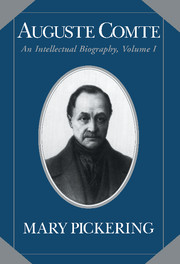Book contents
- Frontmatter
- Contents
- Acknowledgments
- Abbreviations
- Introduction
- 1 The Early Years
- 2 The Life and Works of Saint-Simon up to 1817
- 3 Comte's First Works for Saint-Simon
- 4 Comte's Growing Independence, 1819–1821
- 5 The Fundamental Opuscule and Comte's Rupture with Saint-Simon
- 6 The Aftermath of the Rupture: The Search for Connections
- 7 Comte's Efforts to Establish Himself
- 8 Intellectual and Mental Crises
- 9 The Road to Recovery, 1828–1830
- 10 Years of Success and Confrontation, 1830–1838
- 11 Comte's Changing Psyche and Aberrant Behavior, 1838–1840
- 12 The Encounter between Two Luminaries: Comte and Mill
- 13 1842: A Turning Point
- 14 Cours de philosophie positive: Positivism and the Natural Sciences
- 15 Cours de philosophie positive: Sociology
- Conclusion
- Bibliography
- Index
14 - Cours de philosophie positive: Positivism and the Natural Sciences
Published online by Cambridge University Press: 06 January 2010
- Frontmatter
- Contents
- Acknowledgments
- Abbreviations
- Introduction
- 1 The Early Years
- 2 The Life and Works of Saint-Simon up to 1817
- 3 Comte's First Works for Saint-Simon
- 4 Comte's Growing Independence, 1819–1821
- 5 The Fundamental Opuscule and Comte's Rupture with Saint-Simon
- 6 The Aftermath of the Rupture: The Search for Connections
- 7 Comte's Efforts to Establish Himself
- 8 Intellectual and Mental Crises
- 9 The Road to Recovery, 1828–1830
- 10 Years of Success and Confrontation, 1830–1838
- 11 Comte's Changing Psyche and Aberrant Behavior, 1838–1840
- 12 The Encounter between Two Luminaries: Comte and Mill
- 13 1842: A Turning Point
- 14 Cours de philosophie positive: Positivism and the Natural Sciences
- 15 Cours de philosophie positive: Sociology
- Conclusion
- Bibliography
- Index
Summary
Let us not forget that in almost all minds, even the most elevated, ideas usually remain connected following the order of their first acquisition and that it is, consequently, a failing, which is most often irremediable, not to have begun by the beginning. Each century allows only a very small number of capable thinkers at the time of their maturity, like Bacon, Descartes, and Leibniz, to make a true tabula rasa in order to reconstruct from top to bottom the entire system of their acquired ideas.
Comte, 1830AN INTRODUCTION TO POSITIVE PHILOSOPHY
Comte dedicated the Cours to Joseph Fourier and Blainville, both of whom had been a source of personal encouragement and exemplified the positive spirit in the inorganic and organic sciences respectively. In Comte's view, Fourier's mathematical theory of heat was the most valuable scientific contribution since Newton's law of gravity. Blainville's work was admirable for its synthetic and systematic character and use of classification and hierarchy. His theory that every living being should be studied from two points of view — the static (its conditions) and the dynamic (its actions) — was used throughout the Cours, for Comte believed it could be applied to all phenomena “without exception.”
- Type
- Chapter
- Information
- Auguste ComteAn Intellectual Biography, pp. 561 - 604Publisher: Cambridge University PressPrint publication year: 1993



